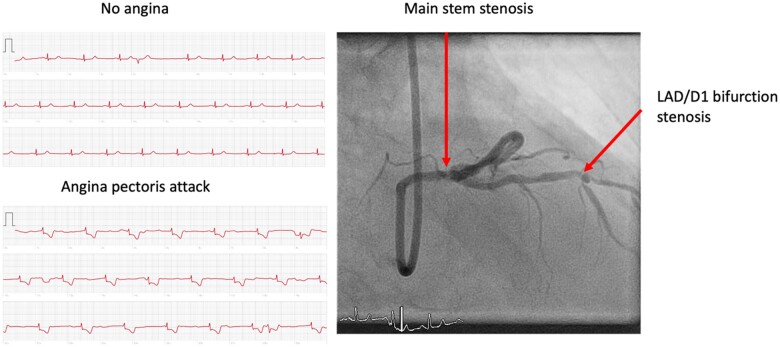An 80-year-old lady with a work history as engineer presented with typical angina symptoms Canadian Cardiovascular Society Class III in our chest pain unit (CPU). She also complained of two episodes of praesyncopy. There reported no vegetative symptoms. Previous history included a diagnosis of arterial hypertension, paroxysmal atrial fibrillation, and an episode of pulmonary embolism 2 years ago. Her current medication included aspirin, telmisartan, nebivolol, atorvastatin, and the organic nitrate pentaerythritol tetranitrate (PETN). The initial 12-channel ECG revealed no evidence for ischaemia. High-sensitive troponin I was also negative. The patient also complained about previous frequent episodes of ectopic beats which were recorded with her Apple watch. Further, Apple watch recordings included tracings with marked ST-segment depression (Panel). Based on this evidence of ischaemia, further diagnostic in the CPU was omitted and the patient was transferred to the catheterization laboratory, where a left main stem stenosis and a left anterior descending/diagonal bifurcation lesion (Panel). Accordingly, the patient was treated with coronary artery stenting and left the hospital a day later.
The development of smart technologies paves the way for new diagnostic possibilities. In the case of the Apple watch, after the mobile application is installed, the records an ECG when a finger is placed on the watch’s digital crown. A 30-s tracing is stored in a PDF file that can be retrieved from the application.
Thus, the Apple watch may be used not only to detect atrial fibrillation or atrioventricular-conduction disturbances but also to detect myocardial ischaemia.
An apple a day may keep myocardial infarction away.
Contributor Information
Michael Drexler, Cardiopraxis Mainz, Germany.
Christian Elsner, Department of Cardiology, University Medical Center Mainz, Johannes Gutenberg University, Langenbeckstraße 1, 55131 Mainz, Germany.
Valentin Gabelmann, Department of Cardiology, University Medical Center Mainz, Johannes Gutenberg University, Langenbeckstraße 1, 55131 Mainz, Germany.
Tommaso Gori, Department of Cardiology, University Medical Center Mainz, Johannes Gutenberg University, Langenbeckstraße 1, 55131 Mainz, Germany.
Thomas Münzel, Department of Cardiology, University Medical Center Mainz, Johannes Gutenberg University, Langenbeckstraße 1, 55131 Mainz, Germany.



